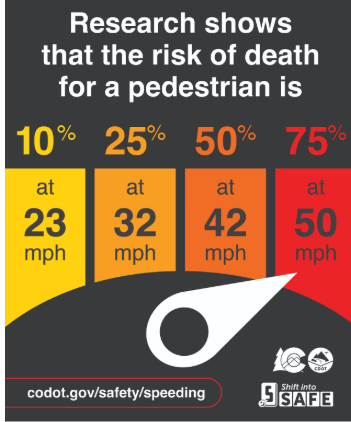Speeding claimed 237 lives on Colorado roads last year
News Release
El exceso de velocidad cobró 237 vidas en las vías de Colorado el año pasado en español.
Access the media kit by emailing [email protected] — to be updated by 3:30 p.m. Mountain Standard Time on Aug. 26.
Statewide — Speed was a factor in 237 fatalities last year, and 1,274 people have died on Colorado roads in speeding-related crashes over the last five years. Speeding drivers are especially dangerous for bicyclists and pedestrians, particularly in urban areas and on neighborhood streets. Since 2016, pedestrian and bicyclist deaths have increased 34% in Colorado while passenger vehicle occupant deaths have increased less than 3%.
To reduce these incidents and raise awareness of the dangers speeding poses to pedestrians and bicyclists, the Colorado Department of Transportation launched a new public outreach campaign alongside advocates, victims and Colorado law enforcement. The campaign aims to spark a conversation about traffic safety and encourage drivers to slow down.
Through a series of infographics, posters and yard signs that will be distributed throughout the state, this new campaign highlights an alarming statistic: As speed increases, so does a pedestrian’s risk of serious injury or death. The average risk of death for a pedestrian reaches 25% at 32 MPH and triples to 75% at 50 MPH, research shows.

Email [email protected] to download the image.
Speed was a leading factor in traffic deaths in Colorado last year, claiming more lives than both impaired driving (215) and unbuckled crashes (189). Driving at unsafe speeds not only endangers the speeding driver, but also puts everyone around them in harm’s way. Colorado is taking action to enforce speed limits, especially on the most sensitive areas on our roads and highways.
The counties that had the most traffic deaths involving speeding in 2024 were Adams (32), El Paso (25) and Denver (23). Of these counties, El Paso County has remained in the top five for speeding citations since 2019, according to the Colorado State Patrol. El Paso County also had the second-highest total traffic deaths and injuries last year, with 78 fatalities and more than 450 serious bodily injuries.
“Speeding drivers put everyone on Colorado roads at risk, especially vulnerable road users like pedestrians, bicyclists and motorcyclists,” said CDOT’s Executive Director Shoshana Lew. “A common misconception is that speeding mainly occurs on highways, but the truth is, it happens on all roads. So, whether you’re on a highway, city street or rural mountain road, slow down and always watch for pedestrians. You could save a life.”
Another common misconception is that speeding saves time. According to a study conducted by AAA Colorado, a motorist moving at 80 MPH instead of 75 MPH would have to travel 100 miles to save roughly five minutes. In fact, the average driver saves just 26 seconds per day by speeding. CDOT reminds motorists that no amount of time saved is worth causing a crash.
According to CDOT’s 2025 Driver Behavior Report, most Colorado drivers (71%) said they drove over the speed limit on main highways at least some of the time. About half (48%) of Colorado drivers admitted to speeding on main city streets.
“Speeding puts you in a lose-lose situation and is never worth the gamble. Not only does speeding put you at risk of a ticket, but it also increases the likelihood of a crash,” said Col. Matthew C. Packard, chief of the Colorado State Patrol. “Running late for work, school, an appointment or your next obligation should never be an excuse to speed or drive recklessly. Remember that speeding inevitably puts you and everyone else at a much greater risk of death or serious injury.”
In 2024, Colorado State Patrol troopers investigated over 560 fatal and injury crashes that involved a speeding driver. CSP issued the most speeding citations for drivers exceeding the posted speed limit by 20+ MPH on the following five roadways:
- I-70
- I-25
- Highway 50
- Highway 24
- Highway 285
CDOT’s goal is to set realistic speed limits that maximize safety and are respected by motorists. CDOT also offers the following tips for staying safe around speeding drivers:
- Maintain Space: Give other drivers, speeding or not, plenty of space. Drivers are more likely to lose control of their vehicles when speeding.
- Do Not Engage: Speeding is often linked to aggressive driving. If a speeding driver is tailgating you or trying to engage in risky behavior, use your judgment to safely steer your vehicle out of the way.
- Report Dangerous Behavior: If you believe a driver is following or harassing you, or engaging in other risky behavior, dial *CSP (*277) or your local law enforcement to report.
The dangers of speeding are especially high in work zones, where lane shifts, narrower lanes or new configurations create hazardous circumstances. CDOT’s Colorado Speed Enforcement Program aims to reduce speed-related crashes and fatalities on Colorado roads and improve safety for drivers, road workers, vulnerable road users and law enforcement. Using Automated Vehicle Identification Systems (AVIS) in high-risk, CDOT-owned corridors, cameras identify vehicles traveling an average of 10 MPH or more over the posted speed limit and automatically issue $75 civil penalties to the registered owner of the vehicle. The program will start first on Colorado Highway 119 and is expected to expand into school zones and other high-risk corridors in the future. More information about the Colorado Speed Enforcement Program can be found at codot.gov/programs/speedenforcement.
Crash Not Accident
Note to reporters: Crashes are no accident — they are preventable. We would appreciate you saying 'crash' instead of 'accident' when reporting.
